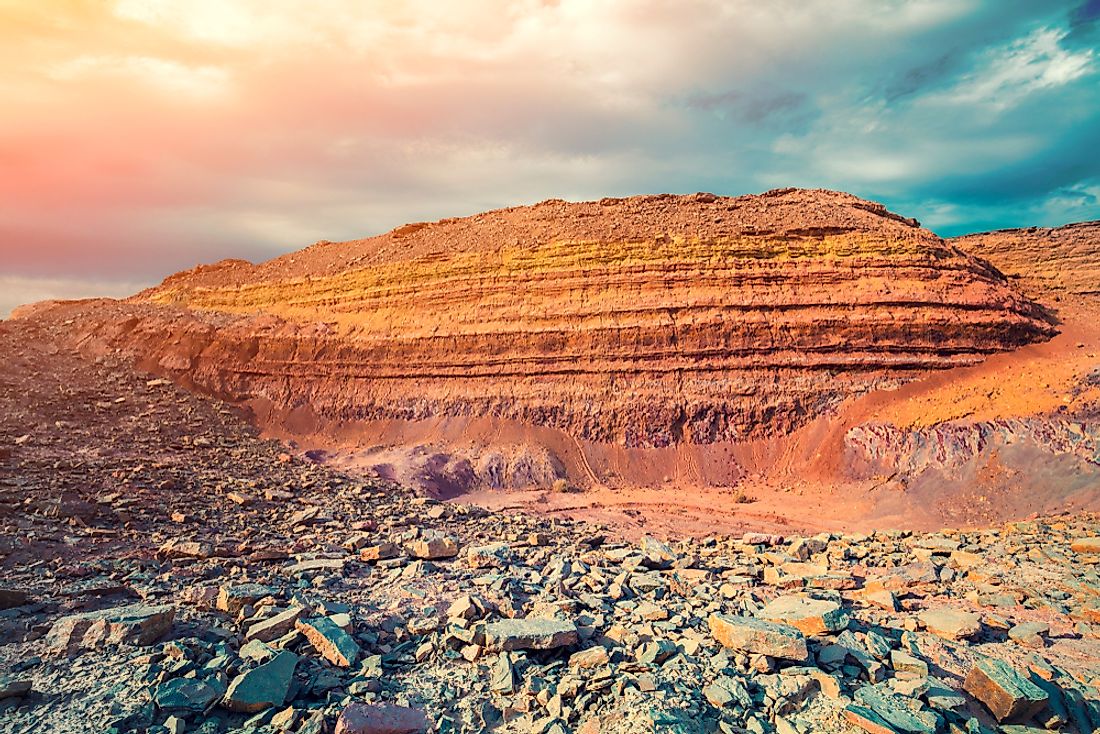What Is A Makhtesh?

A makhtesh is a geological feature found in the Negev Desert in Israel and on the Sinai Peninsula in Egypt. Makhtesh is a Hebrew word that means a mortar due to its resemblance to a grinding mortar. It has the appearance of a crater although it is formed by erosion of soft rocks and minerals. These features are comprised of steep walls that surround a big valley and were formed when the surface of the soft rocks was eroded more than 220 million years ago.
Description
A makhtesh is a unique enclosed valley, which consists of steep walls and colorful rocks that surround the valley. The upper part of the walls is made of dolomite and hard limestone while the bottom section is made of soft sandstone. The feature lacks soil cover and has no vegetation. The ridges inside the valley display colorful layers of rock. The makhtesh showcase 220 million years old geological formations in the Negev desert and the Sinai desert. The valleys are natural treasures that have preserved the deserts flora and fauna for several centuries. Usually, a small river referred to as a ‘wadi’ in Hebrew runs through the valley. The valley provides a home to many desert creatures such as scorpions, lizards, snakes, rodents, porcupines, and turtles among others.
Ramon Makhtesh
The Ramon Makhtesh is the most well-known makhtesh in the world. It is also the world’s largest. It is located in the Negev desert in Israel, and it measures 23.6 miles long, 3.7 miles wide, and 0.28 miles deep. Its walls are covered with 100 million years old volcanic matter, and a unique type of basalt known as basanite occupies the upper parts of the valley. The tiny hills inside Ramon Makhtesh have rare prism elements made of quartzite. The area is home to more than 40 species of desert animals, and it has some beautiful landscapes. The Ramon Makhtesh has a park managed by Israeli authorities. Visitors often hike through the scenic trails or camp at the Be’erot campground.
Large Makhtesh
The Large Makhtesh is located in the Negev desert. It is also known as Makhtesh Gadol. Before the discovery of Ramon Makhtesh, the large Makhtesh was said to be the biggest Makhtesh in the world. It measures 3.1 miles wide and 6.2 miles long. It is situated in the eastern side of Yeruham town. The valley is big enough for vans to drive through.
Small Makhtesh
The Small Makhtesh, also referred to as the Makhtesh Katan, is 3.1 miles wide and 4.3 miles long. The feature was identified by some Jewish researchers in 1942. The Makhtesh Katan is quite small and it can only be accessed on foot. It is found on the northeastern side of Makhtesh Gadol.
Significance of the Makhteshim
The makhteshim are rare and magnificent and locations only found in Israel and Egypt. The sites are famous tourist attractions where visitors go to enjoy the scenic landscape. The valleys have preserved elements that have existed for millions of years in the ridges and walls. The areas provide researchers with an important material used in scientific research. The unique habitats also accommodate rare desert animals that act as a tourist attraction.











